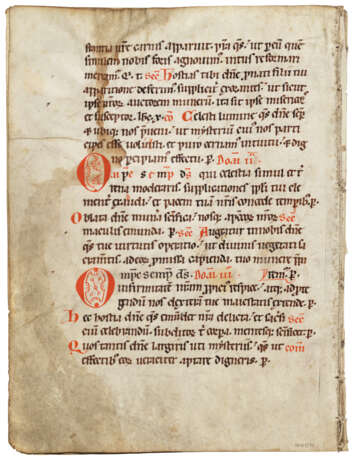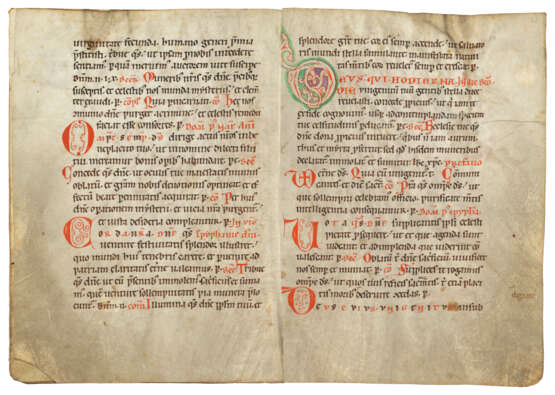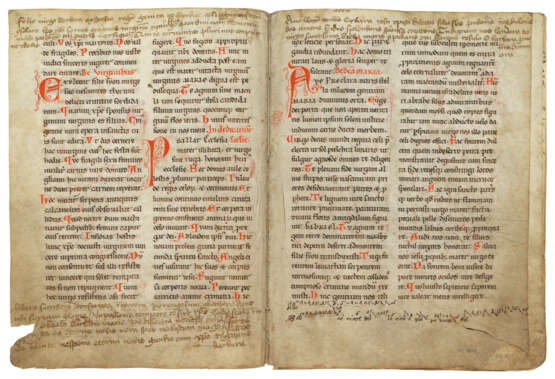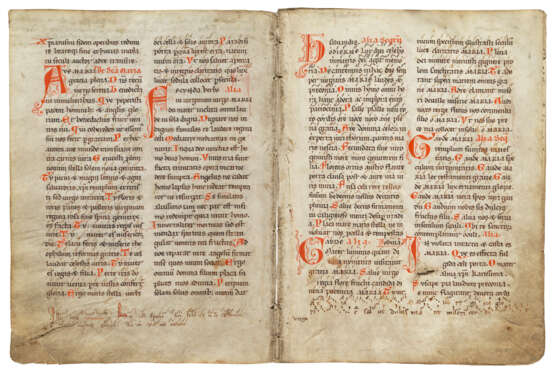ID 1053158
Lot 44 | Early German neumes
Valeur estimée
£ 15 000 – 20 000
Leaves from a Sacramentary, in Latin, decorated manuscript on vellum [Austria or southern Germany, second half 12th century]
A handsome example of Romanesque script with early German neumes: a significant fragment of an important 12th-century Sacramentary - that part of the Roman Missal which contains the prayers and directives for Mass, and a number of sacramental formulas, but does not include the readings of the Mass.
c.290 × 220mm, 8 leaves and one flyleaf, 4 leaves with 27 lines in two columns and 4 with a single column of 21 lines written in Romanesque script, incipit words in majuscules, rubrics and 33 ornamented initials in red, one decorated 6-line initial with leafy infill in red and mauve with green contouring, one 2-line historiated initial with penwork infill depicting a human face, early German diastematic (heightened) staffless neumes, original gathering threads survive, the leaves foliated twice in modern pencil (see reconstruction of the parent manuscript below), f.4 with an earlier roman numeration 'xxxvii', several medieval textual and musical additions in margins (some marginal staining, clean vertical incisions to some inner margins, a few natural flaws to vellum).
Provenance:
(1) The present leaves are (in the modern pencil foliation) ff.4, 17-20, 22-23, and 44 from the same manuscript as ten leaves described by Peter Kidd, The McCarthy Collection, II (2019), no 35, most of which were sold by London dealers in the 1990s. The surviving modern double-pencil foliation suggests that at least 47 leaves from the parent manuscript survived together in the 20th century. The manuscript has in the past been ascribed to southern Germany or Austria (perhaps from the Lambach area). The parent manuscript was evidently updated and enhanced with liturgical additions in subsequent centuries (and indeed, as Kidd points out, it had some leaves replaced): among these additions we find a sequence to the Virgin on f.17 ('Verbum bonum et suave'), various prayers and collects for St Barbara, in different hands on ff.22 and 44 (the Stanford leaf also contains an added mass for St Barbara); two offices for St Thomas of Canterbury on f.22; and masses for St Amandus and Wolfgang, bishop of Regensburg on f.44. The later medieval inscriptions on the surviving flyleaf mention a Mass of St Leopold, which lends greater weight to a localisation in Austria.
(2) The present leaves were owned by Dr Fritz Zeileis, Linz, Austria (1898-1978).
(3) Jörn Günther, Hamburg, April 1992.
(4) Schøyen Collection, MS 1574.
Sister Leaves and Text:
A Sacramentary includes only the words said by the priest at mass; Missals are a far more common type of mass-book, they additionally include texts (and sometimes music) said or sung by other participants. The ‘winter’ part of the Church year (which includes Advent, Christmas, and Epiphany, which all centre around a commemoration of Christ’s birth; and Septuagesima, Lent, Easter, and Pentecost, which centre around a commemoration of his death) has many masses relating to these liturgical feasts. The ‘summer’ part of the Church year is from the end of the Easter-related feasts to the start of Advent. The leaves are listed here according to the modern pencil foliation, but the manuscript must have been out of order when it was foliated: ff.17-20 with the Sequences in double columns, likely belong after f.47.
f.4: Feria I-VI and Ember Saturday in Pentecost, '[...] deus quod operatus' to 'in die clamavi & noc.'
ff.17-20: Common of the Apostles and Martyrs, Virgins, Dedication of a Church, Sequences for the Virgin Mary, the Holy Spirit and the Cross, St Afra, from: 'Quorum verbis verbum' to 'scripsit sibi quinqua[ginta et promeruit esse filia]'.
f.21: 24-26 December, Christmas Eve, Anastasia, Christmas and St Stephen. Sam Fogg, 1996, no 30.
f.22-23: 26 December - 24 January: St Stephen, St John the Apostle, Holy Innocents, Octave of Christmas, first Sunday after Christmas, Vigil of the Epiphany, Epiphany, 1st to 3rd Sundays after Epiphany, from '[nos devotio reddat inno]cuos' to 'veraciter aptare digneris'.
f.26: 3rd Sunday in Quadragesima. Formerly McCarthy Collection, BM 1030.
f.27: 4th Sunday in Quadragesima. Bloomsbury, 6 December 2017, lot 16.
f.28: Maundy Thursday, Good Friday, with a historiated initial of a monk. McCarthy Collection cat.35.
f.?: Vigil of the Ascension to the Vigil of Pentecost. Quaritch, 2000, no 70.
f.34: 2nd to 8th Sundays after Trinity. Christie’s 10 July 2019, lot 501.
f.36: 3rd to 18th Sundays after Trinity Sunday. The Collection of Marvin L. Colker, Christie's 28 November - 12 December 2022, lot 52.
f.38: Vigil of St John the Baptist to Sts Peter and Paul. Sotheby’s, 22 June 2004, lot 3.
f.40: 11-23 August: from Sts Tiburtius and Susanna to Sts Timothy, Hippolytus and Symphorian. The Roger Martin Collection, Bloomsbury, 6 July 2021, lot 13; subsequently Pirages, cat. 81 (2022), no 7.
f.?: 29 August - 14 September: from St John the Baptist to St Gorgonius. Quaritch, 2000, no 69.
f.44: 16 October - 31 October: Callixtus, Gallus, Luke, Simon and Jude, Vigil of All Saints, from '[expedi]at et perpetua salvatione confirmet' to 'quorum recordationibus exhibentur'.
f.47: 29 November - 13 December: the vigil of St Andrew, St Lucy and the beginning of the Common of Saints (apostles and martyrs). Stanford University, 2010-18.
Script and music:
This example of well-developed and conscious Romanesque reveals great regularity in line and spacing and there was evidently no pressure on the scribe as to space. The form, angularity and spacing of the letters is reminiscent of a leaf from another Sacramentary now at the J. Paul Getty Museum in Los Angeles, Ms. Ludwig V 3 - also southern German or Austrian and dating from the third quarter of the 12th century. The diastematic (heightened) neumes represent a first step away from primitive linear musical notation. They give an indication of the relative height among the neumes, but not the exact pitch, as a staff or clef will do.
| Lieu d'origine: | Autriche, Allemagne |
|---|---|
| Catégorie maison de vente aux enchères: | Manuscrits médiévaux et de la Renaissance |
| Lieu d'origine: | Autriche, Allemagne |
|---|---|
| Catégorie maison de vente aux enchères: | Manuscrits médiévaux et de la Renaissance |
| Adresse de l'enchère |
CHRISTIE'S 8 King Street, St. James's SW1Y 6QT London Royaume-Uni | ||||||
|---|---|---|---|---|---|---|---|
| Aperçu |
| ||||||
| Téléphone | +44 (0)20 7839 9060 | ||||||
| Commission | see on Website | ||||||
| Conditions d'utilisation | Conditions d'utilisation |












